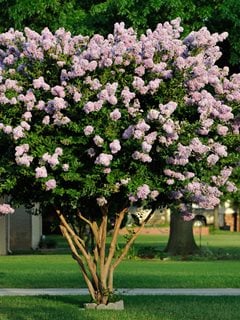How to Prune Crape Myrtle Trees: Tips for Healthy Trees
Learn how to bring out the full potential of this stunning landscape treeCrape myrtle (Lagerstroemia indica), also known as crepe myrtle, is grown for its elegant structure, vibrant flowers, brilliant fall foliage, and attractive bark, providing year-round interest to the landscape. Modern crape myrtles have been bred for disease resistance and sound structural form.
One of the most common problems when growing crape myrtle is improper pruning. A frequent mistake is topping the tree down to thick stubs, a pruning method known as “crape murder.” This improper technique results in an ugly structure and inhibits the attractive bark from maturing, while new growth shoots are spindly and too weak to hold flowers upright. This extreme pruning method stresses and weakens plants, making them more susceptible to pests and diseases, and shortening the life span of the plant.
A crape myrtle that is pruned correctly will have an elegant sculptural structure and sturdy branches that allow flowers to grow upright, as well as an open canopy to showcases the attractive bark. If the right cultivar is chosen and placed correctly in the landscape, most trees will need very little pruning. Here are some pruning tips for crape myrtle trees that will create a show-stopping effect in your landscape.
More on how to grow & care for crape myrtle trees & bushes
CRAPE MYRTLE PRUNING GOALS
Goals of crape myrtle pruning include:
- Direct plant size and shape
- Removal of dead and diseased growth
- Improve air circulation
Aesthetic goals might also include creating a more open canopy, showcasing the decorative bark, and removing spent seed capsules.
CRAPE MYRTLE PRUNING TOOLS
Here are the essential tools for pruning crape myrtle:
- Hand pruners to cut branches less than 1/2 inch thick
- Loppers to cut branches 1- to 2-inches thick
- Pole pruner or hand saw for larger branches
- Heavy work gloves
- Goggles for eye protection
Make sure tools are sharp for precise cutting, and clean to prevent spread of disease. See more: Essential Pruning Tools.
WHEN TO PRUNE CRAPE MYRTLE
The best time to prune crape myrtle is in late winter or early spring before new growth emerges. Pruning later can delay flowering, or sacrifice blooms for that growing season. Fall pruning can cause winter damage.
CRAPE MYRTLE PRUNING TIPS
Proper pruning is key to a beautiful crape myrtle tree. When cutting back crape myrtle plants, avoid harmful pruning practices such as over pruning, topping, or pruning at the wrong time of year. Crape myrtles flower on the current season’s growth. Avoid removing more than 25% of the plant in one pruning, which can cause stress and stunted growth.
- Observe plants: Before pruning, examine plants closely and see where the best places are to prune.
- Go slow: Start out with minimal pruning. If pruning isn’t enough, you can cut back more growth. Over pruning can’t be undone.
- Thin branches: Remove any branches that are growing inwards, as well as crossing branches that can rub together and cause damage to the thin outer layer of the bark.
- Tip back branches: Prune back branches as needed to shape crape myrtle trees, control plant size, and encourage lush growth. Cut each branch 1/4 inch above a growth bud facing the direction you want the new growth to go. Remove side shoots that are thinner than a pencil.
- Open up the canopy: If desired, thin a few of the canopy branches as needed to open up the center of the plant and canopy to allow more sunlight in. Be careful not to overprune to prevent sunscald. Cut back to an outward facing bud to encourage an elegant umbrella shape.
- Remove suckers: Crape myrtle will continue to send out thin suckering twigs from the base of the tree. Trim off suckers as they occur to avoid an unkempt, shrubby appearance.
- Deadhead plants: Although not necessary, removing spent flower heads and seed capsules can encourage rebloom. When deadheading crape myrtle, trim off flower clusters just below the base. Cutting too far below the flower base can remove buds that produce new flowers.
- Remove damaged growth: Cut out any dead, damaged, or diseased growth as it appears.
- Thinning vs. topping: Thinning branches refers to selective removal of branches to create the desired effect. Topping removes the entire top growth of the tree, and is not recommended.
Remember the importance of choosing and siting your new plant; modern crape myrtles need very little care when sited carefully. Mature specimens need very little maintenance. Some gardeners prefer to allow crape myrtles to grow naturally into a shrubby plant that requires little pruning. Encouraging blooms involves basic care, including regular water and fertilizer.
HOW TO REVIVE AN IMPROPERLY PRUNED CRAPE MYRTLE

An improperly pruned crape myrtle, also known as crape murder. Photo by: 3000ad / Shutterstock
Crape myrtle plants that have been pruned into a stumpy habit can be revived with severe pruning. Here are the steps to take:
- Cut plants all the way to the ground. New branches will quickly sprout from the base. Leave plants alone until the following growing season.
- In late winter to early spring before new growth emerges, select 3 to 5 well-spaced branches to keep, and cut the rest of the sprouts back to the ground. The remaining branches will form the new trunks. For a single trunk, cut back all but the sturdiest and most upright branch.
- Follow the rest of the pruning steps, and plants should rebound into healthy attractive trees within 5 years.
RELATED:
Pruning Guides
Pruning Shrubs: A Seasonal Guide
10 Common Pruning Mistakes & How to Avoid Them

